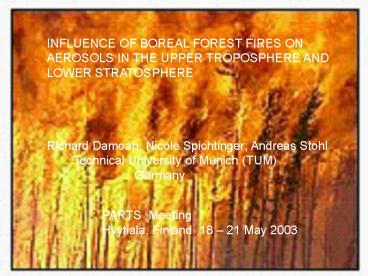PowerPointPrsentation PowerPoint PPT Presentation
1 / 14
Title: PowerPointPrsentation
1
INFLUENCE OF BOREAL FOREST FIRES ON AEROSOLS IN
THE UPPER TROPOSPHERE AND LOWER STRATOSPHERE
Richard Damoah Nicole Spichtinger Andreas
Stohl Technical University of Munich
(TUM) Germany
PARTS Meeting Hyytiala, Finland 18 21 May
2003
2
Overview
- Introduction
- Climatical conditions
- Seasonal variations of forest fire
emissions
- Methodology
- Model used
- Results
- Case Studies
- Conclusion
3
Why are boreal forest fires so important ?
4
- Deforestation
- Boreal Region has about 1b ha of closed forest
(2/3 in Russia and 1/3 in North America).
Kasischke et al.,2000 - In 1998 5 M ha destroyed in Russia (highest in
10yrs) and 4.5 M ha destroyed in Canada (higest
in 5yrs) IFFN, 1999 , 2000
- Sea
- Large amounts of ashes were transported into
Okhotsk sea and Japanese sea during - 1998 fire season. IFFN, 2000
- Atmosphere
- Emit aerosols and trace gases such as CO, NOx
and hydrocarbons which leads - to the formation of O3 Goode et al., 2000
- These species can be transported over long
distances Forster, 2001 Spichtinger, 2001
5
Climatical condition
6
Seasonal total O3 concentration in the Northern
Hemisphere ( gt 50N ) as seen by Global Ozone
Monitoring Experiment ( GOME )
7
Seasonal CO2 and CO anomaly averaged over lat. gt
30N from 1996 to 1999.
8
- Methodology
- SAGE II data were used to detect plumes of
enhanced aerosols - Lagrangian transport model FLEXPART was used to
trace the sources of the aerosol - enhancement
- Finally ATSR hot spot data were used to verify
any fire event in source regions.
9
- Model Overview
- FLEXPART Stohl et al.,1998 Stohl and Thomson,
1999 is a Lagrangian particle dispersion model
that treats both advection and turbulent
diffusion by calculating the trajectories of a
multitude of particles. - It has recently been equipped with convection
scheme Emanuel and Zivkovic-Rothman, 1999 to
account for the sub-gridscale convective
transport. - The model is driven by meteorological data from
ECMWF ECMWF, 1995 (resolution 5, and 31
vertical levels). - FLEXPART can be used in the forward mode to
simulate the dispersion of polutants from a
location, - or in the backward mode to determine the
source - receptor relationship. - In the backward mode, the output is in the unit
of seconds known as the residence time, which is
a measure of the potential contribution of
sources of a certain species to the mixing ration
at the receptor.
10
Results
SAGE II data averaged over Siberia ( lat.
50- 60 N long. 120E 140E) during
the burning season ( May October)
11
CASE ONE 3 8 Aug. 1998
12
CASE TWO 21 26 Sept. 1998
13
CASE THREE 10 15 Octo. 1998
14
Conclusions
- ATSR detected a strong burning season in 1998
in Russia
- SAGE II and TOMS data indicate aerosol
enhancements over Russia - during the 1998 fire season
- FLEXPART simulation shows a strong linkage
between the enhanced - aerosols and the forest fires

